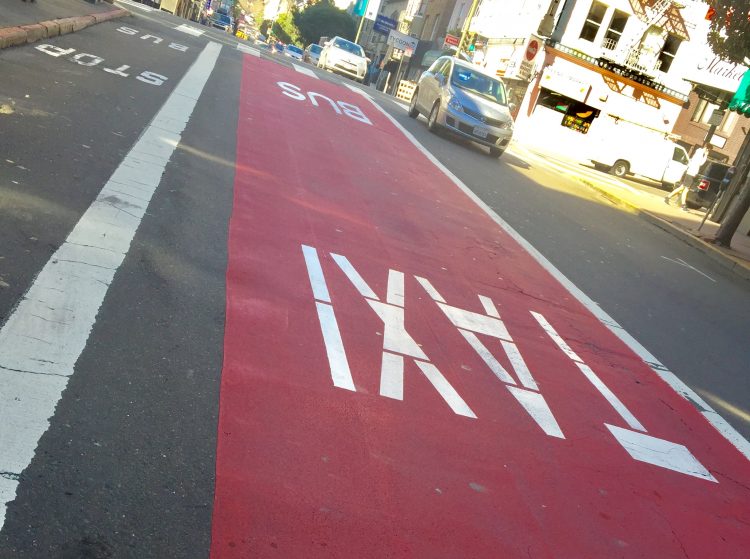
This is a guest post by transportation consultant and former NYC DOT deputy commissioner Bruce Schaller, author of the recent “Empty Seats, Full Streets” and 2017 “Unsustainable?” reports (among others), and a co-author of TransitCenter’s 2016 “Private Mobility, Public Interest”.
Ride services like Uber and Lyft make available a quick and convenient way to get from A to B — comfortable, go anywhere you want to, when you want to. They have attracted legions of users, many of whom are well-educated professionals thrilled to have a car and driver without the hassle or cost of car ownership.
While a boon to mobility, the problem is that there are now more people taking Uber and Lyft than there is space for them on city streets. The result is more traffic, slower buses, and falling transit ridership.
What should cities and transit agencies serving dense urban areas be doing about this? How can they preserve the mobility benefits Uber and Lyft bring to individual users while also addressing the societal and sustainability costs of crowded streets and shrinking transit ridership?
Cities can’t build new streets or widen the ones we have—even if they wanted to. Instead, cities need to make more efficient use of existing streets.
Uber and Lyft have long touted their true ride-share services like UberPool and LyftLine as a way to take people out of cars and speed up traffic. Unfortunately, pooling is not doing the job. The rates of pooling are appallingly low in Manhattan. Over 90% of Uber and Lyft customers in the richest (and most congested) precincts of Manhattan prefer the suburban-style convenience of having their own car and driver over sharing the ride with strangers. The picture is similar in places like Boston (20 percent of Uber and Lyft rides are pooled) and Chicago and San Francisco (17 percent and 26 percent of Lyft trips, respectively. The citywide pooling figures in New York are 18 percent for Lyft and 12 percent for Uber.)
Recent comments by Uber CEO Dara Khosrowshahi reiterate the company’s interest in providing more space-efficient service, in which the density of people in the vehicle matches the density of the urban environment.
How could cities help make this sentiment a reality?
Even cities that do not directly regulate Uber and Lyft have the tools to get these companies to make efficient use of the street through municipal authority over the right of way.
The starting point is prioritizing high-capacity modes as the backbone of any urban transportation system. At least one lane of the most crowded city streets should be dedicated to buses. Transit agencies should switch to off-board fare collection and cities should update traffic signals to maximize bus speeds. Buses can then hop from stop to stop while the lights are green, spending the red cycle letting passengers board and alight. This would make taking the bus virtually as fast as driving.

Second, cities should dedicate a second (and maybe third) lane on high-volume traffic corridors to vehicles carrying multiple passengers. These lanes would be open to personal autos, taxis and for-hire services like Uber and Lyft — provided that have at least two or three passengers. Trucks, equally vital to urban functioning, should also be allowed to use these lanes, provided they strictly follow traffic rules like no double-parking and don’t block the box. Trucks could be required to use newly-enhanced GPS to enforce these terms.
Remaining lane(s) would be open for general traffic with no restrictions. Drivers who want to do their own thing would still be able to. But they would also have better choices than they do today, like bus service that gets them from A to B just as fast as driving.
All of this is possible simply by cities using existing authority to control the right of way and time their traffic signals, and with transit agencies implementing all-door boarding policies.
The concept outlined here can be applied to a myriad of particular contexts. As with any street redesign, the particulars must be tailored to the geometry of each street, how many people use it and where they are going.
The concept could be also applied at choke points, like bridges and tunnels or a set of streets leading into downtown, as an alternative to redesigning an entire corridor. The effect would be to control the number of vehicles crossing at that point, thus making downstream traffic flow far better than it does today.
In all of these schemes, drivers would still have the option of using general purpose lanes, impeded only by the gridlock they already experience. Or they could take a speedy bus, even if that involves a transfer or healthy walk.
Or they could use a pooled Uber or Lyft in the fast lane. They would enjoy the convenience of their own car and driver, albeit joined by a couple of other passengers and maybe having a short walk at each end. It might not be the hassle-free lifestyle they really want, but it might be a necessary part of city living.
 On the Brink: Will WMATA’s Progress Be Erased by 2024?
On the Brink: Will WMATA’s Progress Be Erased by 2024?
The experience of being a WMATA rider has substantially improved over the last 18 months, thanks to changes the agency has made like adding off-peak service and simplifying fares. Things are about to get even better with the launch of all-door boarding later this fall, overnight bus service on some lines starting in December, and an ambitious plan to redesign the Metrobus network. But all of this could go away by July 1, 2024.
Read More A Bus Agenda for New York City Mayor Eric Adams
A Bus Agenda for New York City Mayor Eric Adams
To create the “state-of-the-art bus transit system” of his campaign platform, Mayor Adams will have to both expand the quantity and improve the quality of bus lanes. We recommend these strategies to get it done.
Read More